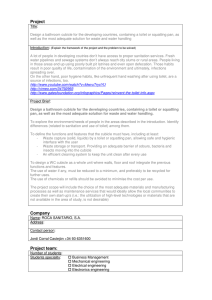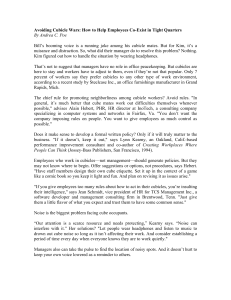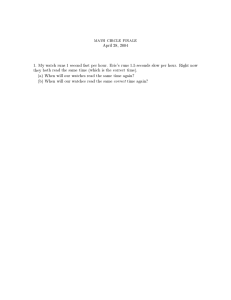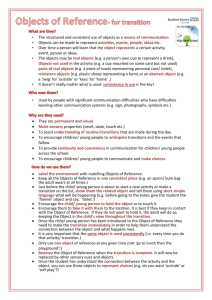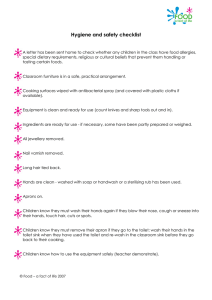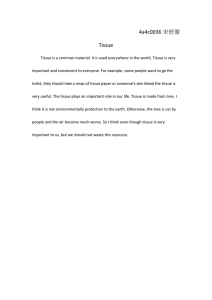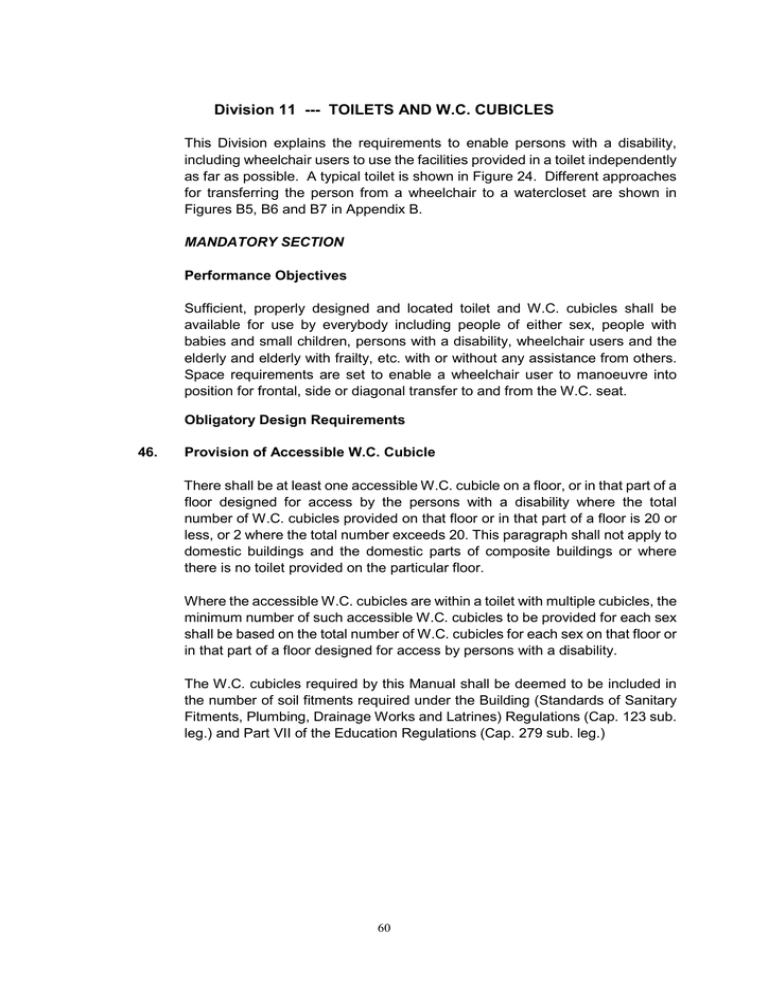
Division 11 --- TOILETS AND W.C. CUBICLES
This Division explains the requirements to enable persons with a disability,
including wheelchair users to use the facilities provided in a toilet independently
as far as possible. A typical toilet is shown in Figure 24. Different approaches
for transferring the person from a wheelchair to a watercloset are shown in
Figures B5, B6 and B7 in Appendix B.
MANDATORY SECTION
Performance Objectives
Sufficient, properly designed and located toilet and W.C. cubicles shall be
available for use by everybody including people of either sex, people with
babies and small children, persons with a disability, wheelchair users and the
elderly and elderly with frailty, etc. with or without any assistance from others.
Space requirements are set to enable a wheelchair user to manoeuvre into
position for frontal, side or diagonal transfer to and from the W.C. seat.
Obligatory Design Requirements
46.
Provision of Accessible W.C. Cubicle
There shall be at least one accessible W.C. cubicle on a floor, or in that part of a
floor designed for access by the persons with a disability where the total
number of W.C. cubicles provided on that floor or in that part of a floor is 20 or
less, or 2 where the total number exceeds 20. This paragraph shall not apply to
domestic buildings and the domestic parts of composite buildings or where
there is no toilet provided on the particular floor.
Where the accessible W.C. cubicles are within a toilet with multiple cubicles, the
minimum number of such accessible W.C. cubicles to be provided for each sex
shall be based on the total number of W.C. cubicles for each sex on that floor or
in that part of a floor designed for access by persons with a disability.
The W.C. cubicles required by this Manual shall be deemed to be included in
the number of soil fitments required under the Building (Standards of Sanitary
Fitments, Plumbing, Drainage Works and Latrines) Regulations (Cap. 123 sub.
leg.) and Part VII of the Education Regulations (Cap. 279 sub. leg.)
60
Obligatory Design Requirements (Cont’d)
47.
Accessible Unisex Toilet
Where toilet is provided on a floor, at least one shall be designed as an
accessible unisex sanitary facility for use by persons of both sexes and access
to which does not necessitate traversing an area reserved for one sex only. It
shall be designed for general use and include adequate circulation space for
wheelchair users in accordance with the obligatory requirements as set out in
this Division.
48.
Location of Accessible W.C. Cubicle
W.C. cubicles shall be accessible –
(i) directly from a public corridor; and
(ii) where situated within a toilet containing other W.C. cubicles, through a
clear space not less than 1500 mm x 1500 mm immediately in front of the
compartment to allow manoeuvrability or by direct approach where no
turning of the wheelchair is necessary.
49.
Design of Accessible W.C. Cubicle
The accessible W.C. cubicle shall not be less than 1500 mm x 1750 mm in area
and the clear manoeuvring space within the cubicle shall not be less than 1500
mm x 1500 mm measured at 350 mm above finished floor level and the cubicle
shall have in it a watercloset at a height not less than 380 mm and not more
than 450 mm, measured to the top of the toilet seat. Waterclosets shall be
equipped with a back support such as a seat lid and seats shall not be
spring-actuated.
50.
Flushing Controls
Flushing control shall be mounted on the wide side of the cubicle at a height
between 600 mm to 1050 mm above the finished floor level and shall be
hand-operated or automatic. Hand-operated controls shall be capable of being
operated with one hand and shall not require tight grasping, pinching or twisting
of the wrist. The force required shall not be greater than 22 N.
51.
Wash Basins
The toilet shall be provided with a wash basin mounted with the rim not higher
than 750 mm above the finished floor level. A clearance of 550 mm shall be
maintained from the finished floor level to the bottom of the apron.
Tap for wash basin shall be automatic or of lever control type without spring
loading, subject to the approval of the Water Supplies Department. Tap shall
not require tight grasping, pinching or twisting of the wrist. The operating force
required shall not be greater than 22 N.
61
Obligatory Design Requirements (Cont’d)
52.
Toilet / Cubicle Doors
Door shall be installed with push-type or lever-type handles and capable of
being easily opened/closed by one hand. Any door fastening shall be capable
of being released from the outside in the event of an emergency.
No coin box shall be affixed to the door of the cubicle.
53.
Grab Rails
There shall be at least two grab rails which shall not be less than 32 mm and not
more than 40 mm in external diameter and shall be fixed on the wall leaving a
grip space of not less than 30 mm clear of the mounting wall. The two grab rails
constructed in one continuous piece is acceptable. The length of grab rail shall
not be less than 600 mm.
There shall be one grab rail fixed on each of both the inner and outer surfaces of
the cubicle door; which shall not be less than 32 mm and not more than 40 mm
in external diameter. The grab rail shall have a grip space of not less than 30
mm clear of each door surface.
There shall be one folding grab rail on the wide side of the cubicle adjacent to
the watercloset at a height between 725mm to 750mm above the finished floor
level when lowered from the wall. Simple instructions in English, Chinese and
Braille on how to unfold the rail should be affixed to the wall. The grab rail,
folding grab rail and wash basin shall be capable of carrying a static load of 150
kg.
The grab rail shall not rotate within its fixing fittings.
54.
Emergency Call Bell
An emergency call bell complying with Division 17 shall be provided in an
accessible W.C. cubicle.
62
Obligatory Design Requirements (Cont’d)
55.
Urinals
If more than one urinal is provided, at least one urinal shall
(i)
have a clear levelled space of not less than 800 mm wide x 1500 mm
deep in front; and
(ii)
be wall hung urinal with a front rim not higher than 400 mm, and have
vertical grab rails of not less than 32 mm and not more than 40mm in
external diameter and of 600 mm length on both sides at a height of 1200
mm above the finished floor level for use by persons with ambulant
disabilities. (see Figure 25)
63
FRONT ELEVATION
SIDE ELEVATION
1750 (MIN.)
600
1500 ( MIN. )
800 (MIN.)
600
PLAN
CLEAR MANOEUVRING SPACE SHALL NOT
BE LESS THAN 1500x1500 MEASURED AT
350 ABOVE FINISHED FLOOR LEVEL
*ALL DIMENSIONS ARE IN mm
DIMENSIONS PRINTED IN BOLD FORM DENOTE OBLIGATORY REQUIREMENT
DIMENSIONS PRINTED IN ITALIC FORM DENOTE RECOMMENDED REQUIREMENT
(Opposite - Handed Layout is Acceptable)
Figure 24 – Accessible Toilet
64
750 - 820
725 - 750
600
600 - 650
380 - 450
725 - 750
900 - 1050
ANGLE BETWEEN TWO
GRAB RAILS 80∘- 90∘
*ALL DIMENSIONS ARE IN mm
Figure 25 – Accessible Urinal
BEST PRACTICE SECTION
A.
Design Considerations
(a)
Adequate and convenient provision of toileting facilities commensurate
with the anticipated use by all users either with or without assistance
from others.
(b)
Appropriate sanitary accommodation should be available to all,
including persons with ambulant disabilities, wheelchair users, the
elderly and people of either sex with babies and small children.
(c)
Provision of a safe environment capable of accommodating the
toileting needs and requirements of persons with a disability or the
elderly.
65
Design Considerations (Cont’d)
B.
(d)
If there is adequate space inside the toilet or cubicle units, double
swing door open both inwards and outwards or sliding door may be
provided to enable assistance during emergency situations.
(e)
Urinals should be accessible and can be easily found by persons with
visual impairment. The grab rails for aiding the elderly and tactile
surface materials for aiding persons with visual impairment should be
provided.
(f)
Accessible unisex toilet facilities can serve both sexes, those with or
without assistance, and accommodate a greater number of users. It is
more easily identified than a facility in a separate-sex toilet and more
likely to be available when required, particularly as the elderly and
some persons with a disability need to use toilets more frequently than
others. In addition, a unisex facility enables assistants of either sex to
assist the user.
(g)
There is a tendency for the specification of sanitary fittings and fixtures
to be in white colour to make cleanliness easily observable. Often the
fittings are set against light or white coloured tiling which makes clear
identification difficult for the persons with visual impairment. Sanitary
fittings should have luminous contrast or colour contrast against the
background finishes.
Recommended Design Requirements
Unisex Facilities
(a)
W.C. cubicles should, where possible, be unisex and accessible from a
corridor so that they can be used by either sex with assistance from
members of the opposite sex, if necessary.
(b)
If two or more accessible unisex facilities are provided, at least one
should be of opposite handed layout to the other(s).
W.C. Cubicles
(c)
The clear distance between the watercloset and the wash basin should
not be more than 600 mm for the users’ convenience after toileting. The
clear manoeuvring space within the cubicle shall not be less than 1500
mm x 1950 mm.
(d)
The angle between the two grab rails should be within the range of 80°
to 90°.
Toilet / Compartment Doors
(e)
Double swing doors which open both inwards and outwards may be
provided in any toilets or cubicles. Sliding door is equally acceptable
provided that it is not heavy or awkward to use.
66
Recommended Design Requirements (Cont’d)
Diaper-changing Facilities
(f)
Diaper-changing facilities should be provided in all toilets unless there is
absolutely no sufficient space (see Figure 26).
*ALL DIMENSIONS ARE IN mm
Figure 26 – Flap-type Diaper Changing Station
67
Recommended Design Requirements (Cont’d)
Bathroom / Shower Compartment
(g)
The floor of the bathroom and the shower compartment should be
slip-resistant with a minimum “static coefficient of friction” of “Good”
grading (see Appendix C) and self-draining.
Luminous Contrast
(h)
Wall tiling should have a minimum luminous contrast of 30% with
sanitary appliances and fittings, grab rails and toilet roll holders, etc.
Avoidance of Obstruction
(i)
Waste pipe, disposal bins and other fittings within the toilet should be
located to avoid any obstruction or creating a tripping hazard including
those under the wash basin.
(j)
Toilets and W.C. cubicles for use by persons with a disability should be
located to avoid proximity to or obstruction by exit doors to the staircase.
Emergency Call Bell
(k)
An additional emergency call bell near the toilet seat should be provided,
if practicable.
Large Size Symbols
(l)
Large size symbols with luminous contrast for male and female toilets
should be used.
68

